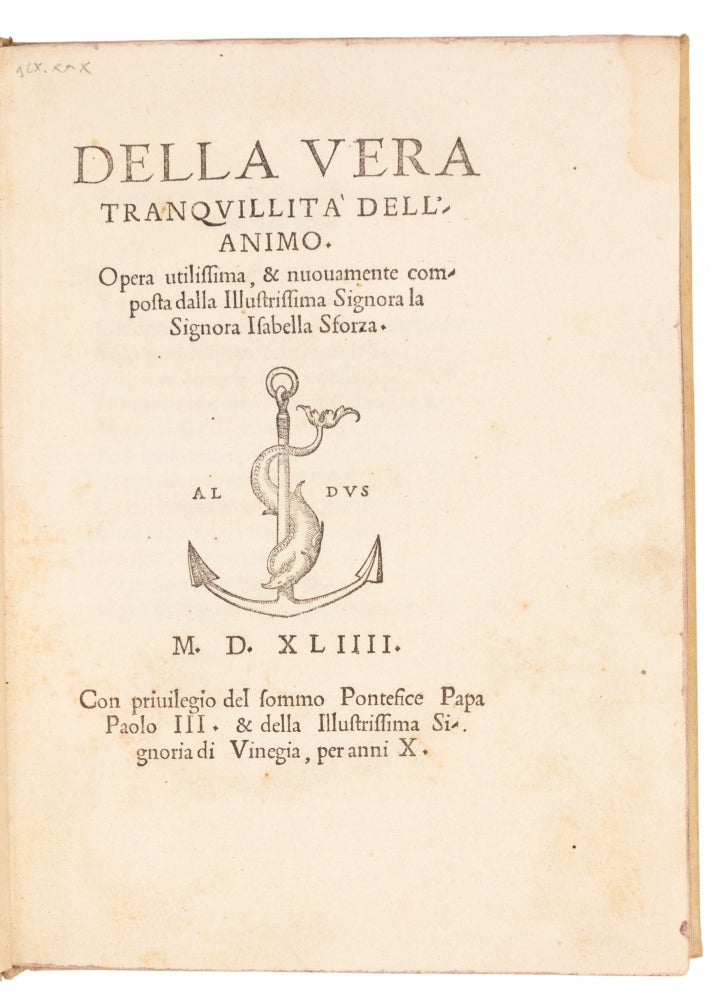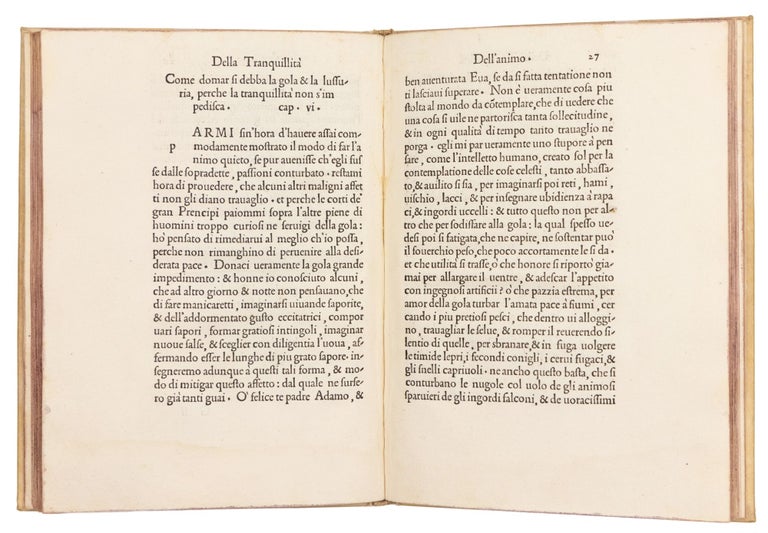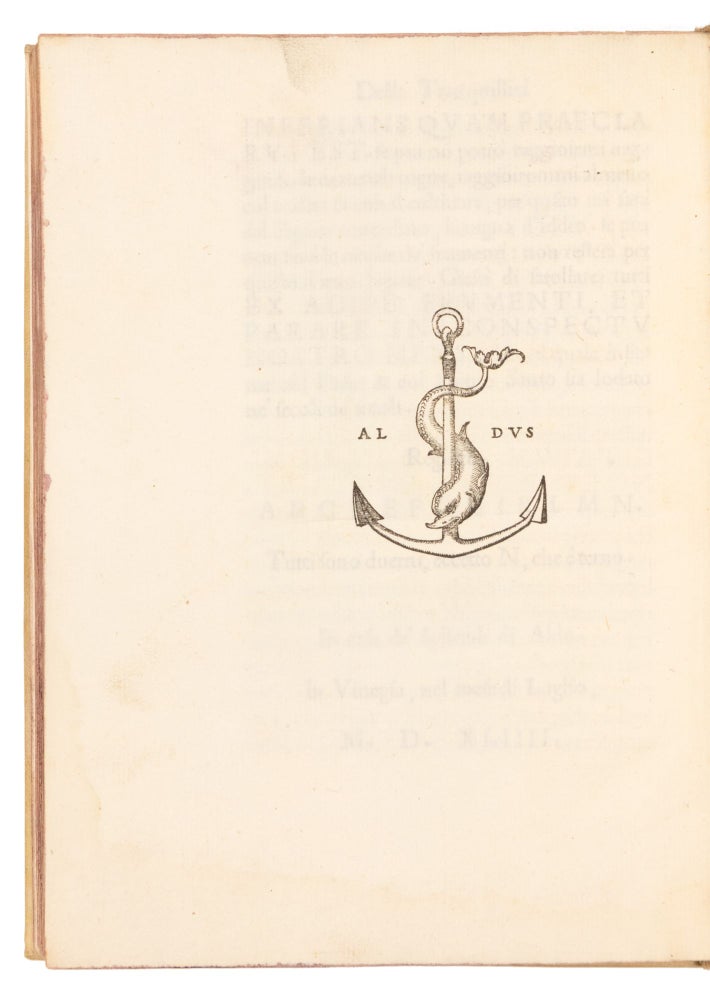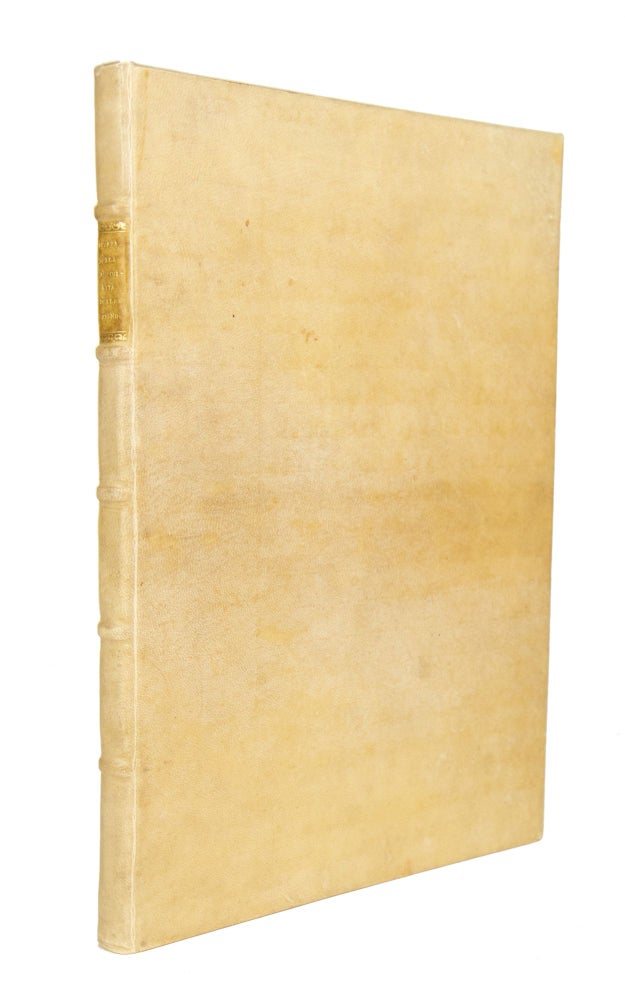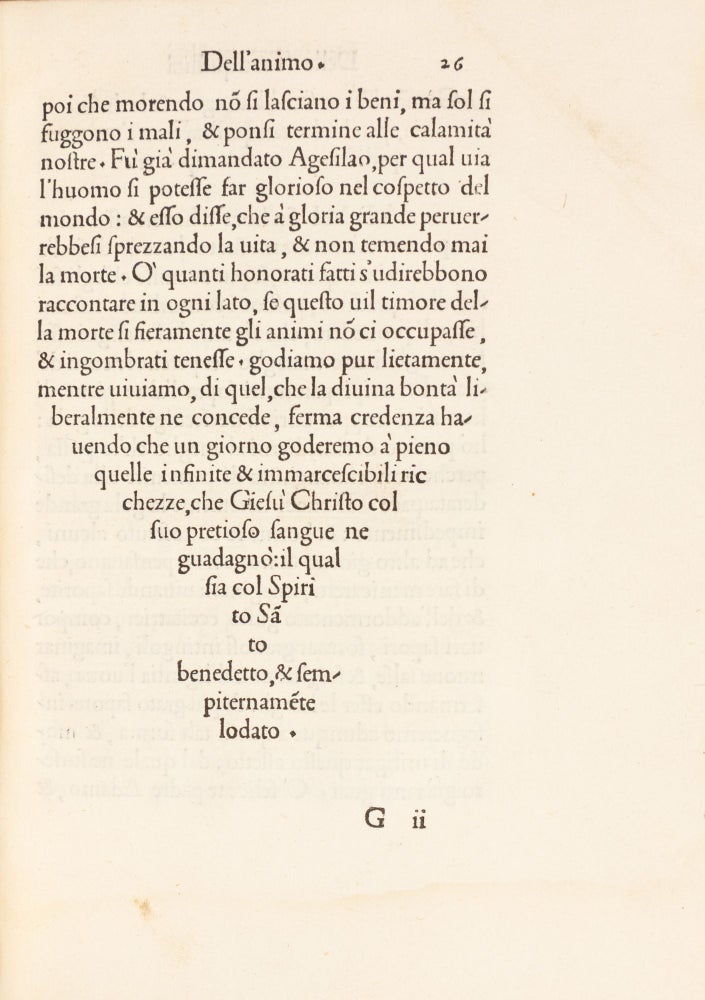Della vera tranquillità dell'animo.
Venice: In casa de' figliuoli di Aldo, July, 1544.
Price: $6,800.00
Quarto: 20.5 x 15 cm. 53, [1] ff. Collation: A-M4 N6
FIRST EDITION.
A very fine copy bound in 20th c. stiff vellum, citron label, gilt on spine. Aldine device on title and final leaf. Broad-margined with just a very light dampstain to the lower margin and a little light soiling and staining to the title; text on bifolium D2-3 lightly printed. Provenance: Giannalisa Feltrinelli (1903–1981), her bookplate.
First edition of this treatise ‘On True Tranquility of the Soul’, published under the name of Isabella Sforza, great-granddaughter of Alessandro Sforza (1409-73) and “the last, and illegitimate, daughter of the Pesaro branch of the illustrious ruling family of Milan”(Daenens). Isabella was the recipient and subject of numerous letters, poems, and dedications by authors such as Pietro Aretino (who wrote that it was his passion for Isabella that kept him from indulging his homosexual desires.) For an assessment of what is known of Isabella and her life, see Daenens, ‘‘Isabella Sforza: Beyond the Stereotype.’’ In Women in Italian Renaissance Culture and Society, ed. L. Panizza, 35–56. Leeds, 2000.
The degree to which Sforza was involved with the publication is still open to question. As it stands, the text was written by its editor, Ortensio Lando, a writer “unique in his persistent and elaborate use of the voices and images of real women as frames and façades for his texts and as vehicles for the discourse within them…. In his extensive literary recourse to female personas, Lando privileged contemporary women who shared his own heterodox religious views”( Ray, Textual Collaboration and Spiritual Partnership in Sixteenth Century Italy: The Case of Ortensio Lando and Lucrezia Gonzaga, in: “Renaissance Quarterly”, 62, 2009, p. 710)
Yet it is still possible that Sforza was herself involved in its conception. “Francine Daenens, using a term employed by Gérard Genette, suggests we characterize the ‘Vera tranquillità’ as an ‘apocryphe consenti’ (that is, published with permission), with Sforza the ‘garant du texte’ (textual guarantor): surely the impersonation was so extensive that Isabella must have been a party to it and the text must have had the authority of her assent?” (ibid.)
Lando tells us that he visited Sforza and that it was she who gave him the manuscript. “In his dedication to Otto Truchsess von Waldburg, Lando explains that he himself had just written a short treatise on the same subject in the course of a trip abroad, but that upon his way back from Picardy, stopping as usual in Piacenza to visit his old friend Isabella Sforza, he was surprised to find her preoccupied with the same problem. She showed him the manuscript of her own work and Lando, considering this to be much superior, decided to publish her treatise. He begs the bishop to read it carefully, because it demonstrates what a woman can achieve in the study of letters: ‘quanto possa negli studi delle buone lettere il sesso femminile, pur che vi si applichi, & pur che vi si esserciti.’ (p. 4).”(Erdmann, My Gracious Silence, entry 121)
“The earliest major example of Lando writing as a woman is the spiritual treatise ‘Della vera tranquillità dell’animo’, which bears the name of Isabella Sforza (1503–61), an illegitimate daughter of a branch of the powerful Milanese family. Scholars have attributed this work to Lando on the basis of similarities to his other works as well as contemporary evidence supporting his authorship; Sforza’s role as a partner in the volume’s conception and production is unknown. What little biographical information exists regarding Isabella Sforza suggests that she was known, at least for a time, to espouse the spiritualist and quietistic views attributed to her in this treatise. As the title suggests, the ‘Vera tranquillità dell’animo’ celebrates faith as an internal experience — a kind of personal illumination — and as a serenity that derives from the certainty of salvation: as Daenens explains, ‘an inner peace . . . with a clear connotation of reformist dogma.’ Lando may have been Sforza’s spiritual guide, although in the treatise’s dedication he acknowledges her superiority; and this text, as Daenens has shown, contributed to solidifying Sforza’s fame on the basis of her religious views.”(Ibid, p. 699)
References: Daenens, ‘‘Isabella Sforza: Beyond the Stereotype.’’ In Women in Italian Renaissance Culture and Society, ed. L. Panizza, 35–56. Leeds, 2000; Daenens, Le traduzioni Della vera tranquillità dell'animo, 1544: L'irriconoscibile Ortensio Lando, in: Bibliothèque d'Humanisme et Renaissance, LVI/3, 1994, p. 673).
Renouard, Annales de l'imprimerie des Aldes, 129.1; UCLA Ahmanson-Murphy 318; Adams S-1044; BM/STC Italian 624; Gamba 1646


